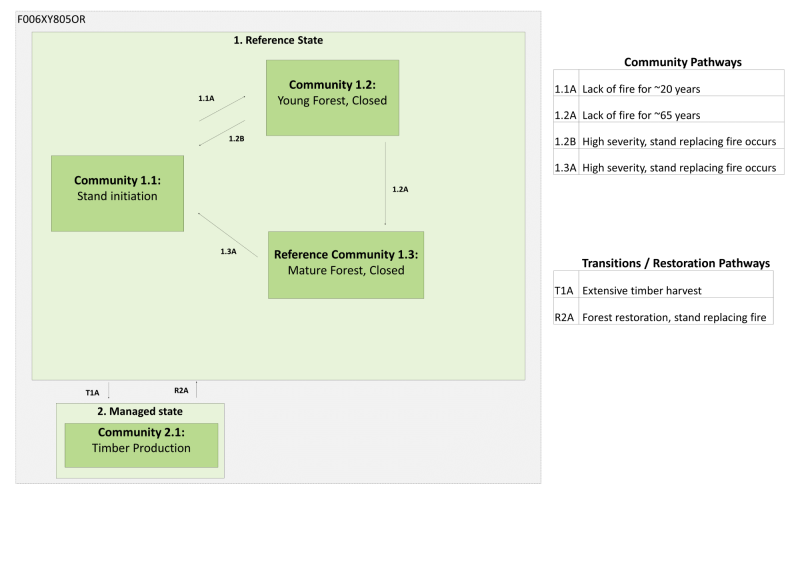
Natural Resources
Conservation Service
Ecological site F003XD805OR
Frigid Udic Maritime Mountain Slopes 40-60 PZ
Last updated: 4/01/2025
Accessed: 12/21/2025
General information
Provisional. A provisional ecological site description has undergone quality control and quality assurance review. It contains a working state and transition model and enough information to identify the ecological site.
MLRA notes
Major Land Resource Area (MLRA): 003X–Olympic and Cascade Mountains
This area includes the west slope and parts of the east slope of the Cascades Mountains in Washington and Oregon. The Olympic Mountains in Washington State are also included. These mountains are part of a volcanic arc located at a convergent plate boundary. Volcanic rocks predominate but metamorphic and sedimentary rocks occur in the North Cascades and Olympic Mountains. Topography is generally dissected and steep, but some areas consist of constructional volcanic platforms and isolated stratovolcanoes. Elevation is usually 500 to 6000 feet but reaches to 14,410 ft at the summit of Mount Rainier. Many areas hosted alpine glaciers or ice sheets during the Pleistocene, and a few remain today.
Climate becomes cooler and moister with increasing elevation and latitude. Low elevations experience a long growing season and mild temperatures. High elevations can accumulate snowpack lasting into summer and frost may occur in any month. Average annual precipitation ranges from 60 to 180 inches in most areas. Most precipitation falls during the fall, winter, and spring during low-intensity frontal storms. Summers are relatively dry. Average annual temperature is 27 to 50 degrees F. The frost-free period is 10 to 180 days.
Classification relationships
Forested Plant Associations of the Oregon East Cascades (Simpson 2007)
CWF431 – white fir–grand fir/queencup beadlily
Plant association group – White fir / Grand fir, wet
Plant Associations of the Commercial Forest of the Warm Springs Indian Reservation (Marsh 1987)
Grand fir / Snowberry
Grand fir / Oregon Boxleaf
Grand fir / Vine Maple
Landfire biophysical settings model (Landfire 2007)
0710180 East Cascades Mesic Montane Mixed-Conifer Forest and Woodland.
Ecological site concept
This site encompasses a broad group of forest communities encompassed by the wet, modified maritime influenced, mixed conifer zone at middle elevations on the east slope of the Oregon Cascades. In reference condition, this site supports a forest canopy dominated by Douglas-fir (Pseudotsuga menziesii) and grand fir (Abies grandis), with western larch (Larix occidentalis) and understory reproduction of Douglas-fir and grand fir common. Plant community diversity is high with many wet site indicator species present such as bigleaf huckleberry (Vaccinium membranaceum), Oregon boxwood (Paxistima myrsinites), vine maple (Acer circinatum), vanilla leaf (Achlys triphylla), twinflower (Linnaea borealis) and beadlilly (Clintonia uniflora).
Sites at higher elevations than this site receiving cooler temperatures, higher precipitation, and in many cases more favorable aspects that result in increased effective soil moisture, support codominance of western hemlock (Tsuga heterophylla) due to its greater moisture requirements. In comparison to the associated mixed conifer sites receiving less precipitation, the maritime influence of this site results in a udic rather than xeric soil moisture regime with greater available moisture during the summer season. The higher soil moisture conditions of this site, as well as cooler temperatures, result in a less frequent fire rotation in comparison to these drier sites. This site has a fire regime characterized by moderately frequent, low and mixed severity fire (Landfire fire regime group 3).
This is a provisional ecological site that groups characteristics at a broad scale with little to no field verification and is subject to extensive review and revision before final approval. All data herein was developed using existing information and literature and should be considered provisional and contingent upon field validation prior to use in conservation planning.
Associated sites
| F003XD806OR |
Frigid Udic Maritime Mountain Slopes 60-90 PZ Occupying landforms upslope or landscape positions with greater precipitation and/or soil moisture accumulation and retention. |
|---|
Similar sites
| F003XD806OR |
Frigid Udic Maritime Mountain Slopes 60-90 PZ Higher precipitation, dominated by western hemlock |
|---|
Table 1. Dominant plant species
| Tree |
(1) Abies grandis |
|---|---|
| Shrub |
Not specified |
| Herbaceous |
(1) Clintonia uniflora |
Click on box and path labels to scroll to the respective text.
Ecosystem states
| T1A | - | Extensive Timber Harvest |
|---|---|---|
| R2A | - | Forest restoration, stand replacing fire |
State 1 submodel, plant communities
| 1.1A | - | Lack of fire for ~20 years |
|---|---|---|
| 1.2B | - | High severity, stand replacing fire occurs |
| 1.2A | - | Lack of fire for ~65 years |
| 1.3A | - | High severity, stand replacing fire occurs |
